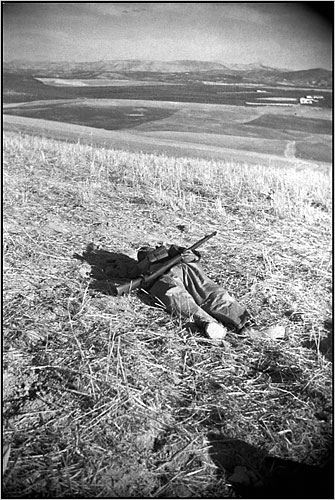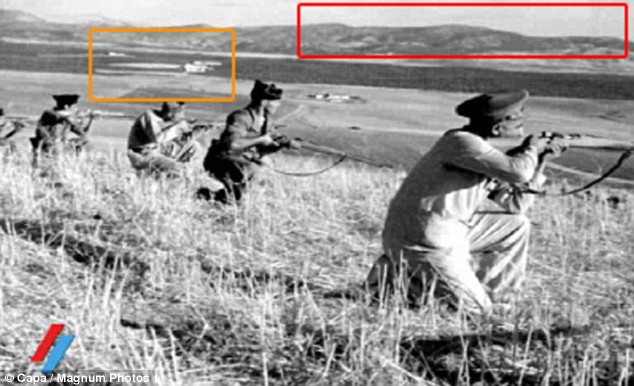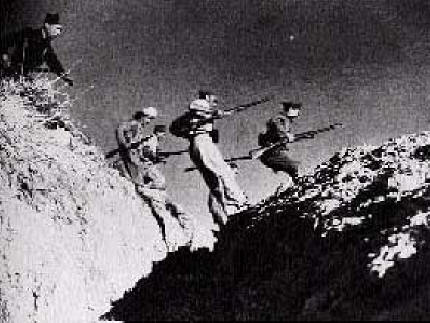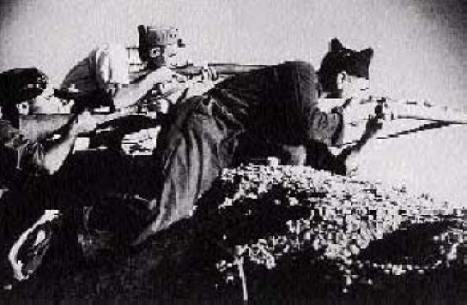
“With lively step, breasting the wind, clenching their rifles, they ran down the slope covered with thick stubble. Suddenly their soaring was interrupted, a bullet whistled — a fratricidal bullet — and their blood was drunk by their native soil” – French magazine Vu 23/9/36
The Falling Soldier, Loyalist Militiaman at the Moment of Death, Cerro Muriano, September 5, 1936
The Falling Soldier is one of the world’s best known war photographs of all time. Taken by Robert Capa on 5 September, 1936, during the battle for Cerro Muriano, a town 20 kilometres north of Córdoba.
The man in the photo is Federico Borrell García, a 24-year-old man from Alcoy/Alcoi in the Valencia region. He had traveled as part of the Columna Alcoiana sent to Córdoba to help them fight off the ever-advancing Nationalist forces. Borrell, nicknamed Taino, was shot at around 5pm at La Loma de las Malagueñas, a hill outside the town of Cerro Muriano, when the column was attacked from behind. He was the only man in the Columna Alcoiana to be killed that day. The photo is listed to show a man from the Iberian Federation of Libertarian Youth (FIJL), but Borrell, an anarchist, was later identified through the photo by his brother, Everisto.
Falling Soldier shows Borrell at the moment of death. He was shot through the head (some reports say the heart), killing him before he even fell. The photo was one of seven taken in sequence quite by luck (on Capa’s part at least) before Borrell lands on his back, with his rifle still slipping from his hand. At the time, Robert Capa was in a gully/trench on the hill, hidden from the enemy fire, holding his camera high above his head to capture the fighting. Soon after, Falange members from the Nationalists claimed the photo was a fake, but for forty years, the photo was considered one the best war shots of all time (the other great shot, also Capa’s, was of soldiers landing on D-Day).

Posing in the gully – Borrell is the man on the left above, and then the man below –

These photos, shot six and seven in the sequence, are of another man, the man third of the left in the top photo –


Since 1975, complaints about the photo have raged. Capa, (who died in 1954 when he stood on a landmine in now-Vietnam), was defended by his brother, stating the photo was authentic. Capa’s famous photograph sidekick, Gerda Taro, died during the war in 1937. Many photos in the Spanish Civil War were staged because journalists and photographers couldn’t get to the front lines to see the action. Capa had been forced to stage before, and on this very day, said he had been relaxed with the soldiers during a quiet period before an ambush.
Capa always claimed the photo was taken at La Loma de las Malagueñas outside Cerro Muriano, but naysayers claim it was taken at Espejo, over 50 kilometres south from Cerro Muriano. It is also stated that Borrell is not the man in the photo, despite being identified by his own brother.
In 2009, José Manuel Susperregui Echeveste, a professor from the University of the Basque Country, released Sombras de Fotografía (Shadows of Photography – well worth a look, along with many of his books). The professor studied the backgrounds of Capa’s photograph, and worked with historians in the area of Córdoba to determine the landscape, and it was Espejo, not Cerro Muriano, that was claimed in the shots.
Susperregui’s theory maintains that the Falling Soldier shot was staged, but the others in the sequence are real. Also to back up the professor’s claims, is the fact the Capa gave contradicting statements on the events of the day. Capa is recorded as saying Borrell was shot by a sniper, and another time by machine-gun fire. He also spoke of taking the photo, both in and out of the gully on the hillside. As the landscape of Espejo hasn’t changed from 1936 to present day, reporters have been out photographing the region in an attempt to find the exact location, with many claiming success.


1936 ‘Cerro Muriano’ and 2009 Espejo, by Magnum Photos
Others also claim that perhaps Borrell was killed by a sniper while posing for photographs for Capa. Susperregui addressed those rumours as well, claiming there were no snipers in the Córdoba area at the time, a suggestion difficult to verify. The inconsistencies also lead people to suggest the photo was taken by Gerda Taro, not Capa, as has been discovered in Capa’s collection in recent years. Some claim they saw Borrell get shot, others claim Borrell was posing for a photo and was killed, leading Capa to rarely speak about the events.



It was the Mexican Suitcase discovery in 2009 that then further discredited Falling Soldier. In 2009, a suitcase was found, holding Capa’s negatives from his career, which were sent to Mexico after the war. The photos of Robert Capa, Gerda Taro and David Seymour were all thrown in together. The incredibly talented Gerda Taro died just short of her 27th birthday in 1937, in an accident with a Republican tank. The immense David Seymour, or David Chim, ran Magnum Photos until his death by machine gun during the 1956 Suez War. What the Mexican suitcase showed, that while there were negatives of the sequence of the Falling Soldier, photo number five of seven, the famous shot, was missing.
The Mexican Suitcase tour was a huge success, with the photos in galleries widely seen. Other photos in the sequence were also displayed, including shot five, despite no negative found. The negatives in the suitcase have been analysed, and results show it is Espejo, not Cerro Muriano in the background. Because the sixth and seventh shots show a dead soldier, someone other than Borrell, leads many to say the famous photo was staged. Meanwhile, many others claim it is still completely real, based on the angles, the recollections of Capa, and the details of fighting on September 5, 1936. The photo shows a scene far removed from traditional war shots and different to other staged photos of injured men, meaning there will probably never be a real answer to what killed Borrell, when, where, or if it is really Borrell at all. We will never really know.
Me? I like to believe the photo is real. Why? my own personal sense of whimsy. I would like to believe maybe Gerda Taro took that photo, hence why Robert Capa couldn’t recall the details correctly. Gerda Taro was the first female war photographer, brilliant and daring in her short lifetime. After all, who is Robert Capa? Not an American photographer, rather Endre Friedmann from Hungary, the same way Taro was Gerta Pohorylle from Germany, the pair having to flee their homelands and invent Robert Capa in Paris. Her work was often used under the name Robert Capa. History isn’t fond of powerful women. My theory is total speculation, based on nothing but my own ideas and a love of feminism. Maybe the theory of them all, thinking they were safe, outside the town, were talking and taking photos when a bullet really did strike down Borrell, and no one wanted to talk about it.
Perhaps it is a fake, something that had us all fooled for 80 years. If Falling Soldier isn’t real, it is still a posed shot to display what happened to so many Spaniards, that even now there isn’t an agreed figure on the number of dead. No one who has seen Capa’s collection can doubt his abilities, and is it really that hard to believe that a photo can be taken at that moment when life is taken away?
Either way, rest in peace, Federico Borrell García of Alcoi, Valencia – January 3, 1912 – September 5, 1936
~~
This is not a full detailed analysis, instead a simplified report of Falling Soldier and its authenticity. Feel free to suggest an addition/clarification/correction below. All photos are linked to source for credit.
